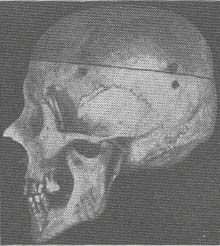Related Research Articles

The master race is a pseudoscientific concept in Nazi ideology in which the putative "Aryan race" is deemed the pinnacle of human racial hierarchy. Members were referred to as "Herrenmenschen".

The Dinaric race, also known as the Adriatic race, were terms used by certain physical anthropologists in the early to mid-20th century to describe the perceived predominant phenotype of the contemporary ethnic groups of southeast Europe.
Discrimination based on skin tone, also known as colorism or shadeism, is a form of prejudice and discrimination in which people of certain ethnic groups, or people who are perceived as belonging to a darker-skinned race, are treated differently based on their darker skin tone.
The concept of race as a categorization of anatomically modern humans has an extensive history in Europe and the Americas. The contemporary word race itself is modern; historically it was used in the sense of "nation, ethnic group" during the 16th to 19th centuries. Race acquired its modern meaning in the field of physical anthropology through scientific racism starting in the 19th century. With the rise of modern genetics, the concept of distinct human races in a biological sense has become obsolete. In 2019, the American Association of Biological Anthropologists stated: "The belief in 'races' as natural aspects of human biology, and the structures of inequality (racism) that emerge from such beliefs, are among the most damaging elements in the human experience both today and in the past."
Scientific racism, sometimes termed biological racism, is the pseudoscientific belief that the human species can be subdivided into biologically distinct taxa called "races", and that empirical evidence exists to support or justify racism, racial inferiority, or racial superiority. Before the mid-20th century, scientific racism was accepted throughout the scientific community, but it is no longer considered scientific. The division of humankind into biologically separate groups, along with the assignment of particular physical and mental characteristics to these groups through constructing and applying corresponding explanatory models, is referred to as racialism, race realism, or race science by those who support these ideas. Modern scientific consensus rejects this view as being irreconcilable with modern genetic research.

Circassian beauty is a stereotype and a belief referring to the Circassian people. A fairly extensive literary history suggests that Circassian women were thought to be unusually beautiful and attractive, spirited, smart and elegant, and as such were desirable. A smaller but similar literature also exists for Circassian men, who were thought to be especially handsome.
The Mediterranean race is an obsolete racial classification of humans based on a now-disproven theory of biological race. According to writers of the late 19th to mid-20th centuries it was a sub-race of the Caucasian race. According to various definitions, it was said to be prevalent in the Mediterranean Basin and areas near the Mediterranean, especially in Southern Europe, North Africa, most of West Asia, the Middle East or Near East; western Central Asia, parts of South Asia, and parts of the Horn of Africa. To a lesser extent, certain populations of people in Ireland, western parts of Great Britain, and Southern Germany, despite living far from the Mediterranean, were thought to have some minority Mediterranean elements in their population, such as Bavaria, Wales, and Cornwall.

The Alpine race is a historical race concept defined by some late 19th-century and early 20th-century anthropologists as one of the sub-races of the Caucasian race. The origin of the Alpine race was variously identified. Ripley argued that it migrated from Central Asia during the Neolithic revolution, splitting the Nordic and Mediterranean populations. It was also identified as descending from the Celts residing in Central Europe in Neolithic times. The Alpine race is supposedly distinguished by its moderate stature, neotenous features, and cranial measurements, such as high cephalic index.
Identifying human races in terms of skin colour, at least as one among several physiological characteristics, has been common since antiquity. Such divisions appeared in rabbinical literature and in early modern scholarship, usually dividing humankind into four or five categories, with colour-based labels: red, yellow, black, white, and sometimes brown. It was long recognized that the number of categories is arbitrary and subjective, and different ethnic groups were placed in different categories at different points in time. François Bernier (1684) doubted the validity of using skin color as a racial characteristic, and Charles Darwin (1871) emphasized the gradual differences between categories. Today there is broad agreement among scientists that typological conceptions of race have no scientific basis.
Polygenism is a theory of human origins which posits the view that the human races are of different origins (polygenesis). This view is opposite to the idea of monogenism, which posits a single origin of humanity. Modern scientific views find little merit in any polygenic model due to an increased understanding of speciation in a human context, with the monogenic "Out of Africa" hypothesis and its variants being the most widely accepted models for human origins. Polygenism has historically been heavily used in service of white supremacist ideas and practices, denying a common origin between European and non-European peoples. It can be distinguished between Biblical polygenism, describing a Pre-Adamite or Co-Adamite origin of certain races in the context of the Genesis narrative of Adam and Eve, and scientific polygenism, attempting to find a taxonomic basis for ideas of racial science.

Pareronia valeria, the common wanderer or Malayan wanderer, is a medium-sized butterfly of the family Pieridae, that is, the yellows and whites, and is found in India and Southeast Asia. The butterfly found in India is sometimes considered as a separate species, Pareronia hippia.
Social interpretations of race regard the common categorizations of people into different races. Race is often culturally understood to be rigid categories in which people can be classified based on biological markers or physical traits such as skin colour or facial features. This rigid definition of race is no longer accepted by scientific communities. Instead, the concept of 'race' is viewed as a social construct. This means, in simple terms, that it is a human invention and not a biological fact. The concept of 'race' has developed over time in order to accommodate different societies' needs of organising themselves as separate from the 'other'. The 'other' was usually viewed as inferior and, as such, was assigned worse qualities. Our current idea of race was developed primarily during the Enlightenment, in which scientists attempted to define racial boundaries, but their cultural biases ultimately impacted their findings and reproduced the prejudices that still exist in our society today.

Colotis fausta, the large salmon Arab, is a small butterfly of the family Pieridae, that is, the yellows and whites, which is found in Israel, Syria, Turkey, Iran, Afghanistan, Turkmenistan, India, Arabia, Chad, Somalia and United Arab Emirates.

An aquiline nose is a human nose with a prominent bridge, giving it the appearance of being curved or slightly bent. The word aquiline comes from the Latin word aquilinus ("eagle-like"), an allusion to the curved beak of an eagle. While some have ascribed the aquiline nose to specific ethnic, racial, or geographic groups, and in some cases associated it with other supposed non-physical characteristics, no scientific studies or evidence support any such linkage. As with many phenotypical expressions it is found in many geographically diverse populations.
Brown is a racialized classification of people, usually a political and skin color-based category for specific populations with a light to moderate brown complexion.
Various attempts have been made, under the British Raj and since, to classify the population of India according to a racial typology. After independence, in pursuance of the government's policy to discourage distinctions between communities based on race, the 1951 Census of India did away with racial classifications. Today, the national Census of independent India does not recognise any racial groups in India.

Brazilian society is made up of a confluence of people of Indigenous, Portuguese, and African descent. Other major significant groups include Italians, Spaniards, Germans, Lebanese, and Japanese.
Mongoloid is an obsolete racial grouping of various peoples indigenous to large parts of Asia, the Americas, and some regions in Europe and Oceania. The term is derived from a now-disproven theory of biological race. In the past, other terms such as "Mongolian race", "yellow", "Asiatic" and "Oriental" have been used as synonyms.
Negroid is an obsolete racial grouping of various people indigenous to Africa south of the area which stretched from the southern Sahara desert in the west to the African Great Lakes in the southeast, but also to isolated parts of South and Southeast Asia (Negritos). The term is derived from now-disproven conceptions of race as a biological category.

The description of populations as white in reference to their skin colour predates and is distinct from the race categories constructed from the 17th century onward. Coloured terminology is occasionally found in Graeco-Roman ethnography and other ancient and medieval sources, but these societies did not have any notion of a white or pan-European race. In Graeco-Roman society whiteness was a somatic norm, although this norm could be rejected and it did not coincide with any system of discrimination or colour prejudice. Historically, before the late modern period, cultures outside of Europe and North America, such as those in the Middle East and China, employed concepts of whiteness. Eventually these were progressively marginalised and replaced by the European form of racialised whiteness. Whiteness has no enduring "true essence", but instead is a social construct that is dependent on differing societal, geographic, and historical meanings. Scholarship on race distinguishes the modern concept from pre-modern descriptions, which focused on skin colour, complexion and other physical traits.
References
- ↑ John Frost (1856). Grand illustrated encyclopedia of animated nature: Embracing a full description of the different races of men, and of the characteristic habits and modes of life of the various beasts, birds, fishes, insects, reptiles, and microscopic animalcula of the globe. Being a complete history of the animal kingdom. Miller, Orton & Mulligan. pp. 8–. Retrieved 20 April 2013.
- ↑ Charles Pickering; John Charles Hall (1854). The Races of Man: And Their Geographical Distribution. George Bell & Sons. pp. 180–. Retrieved 20 April 2013.